Even in a city of architectural splendour, Vienna’s Schonbrunn Palace manages to stand out without much effort. Not a surprising fact considering the property, a Habsburg summer palace, was designed to rival Versailles. It was created with the lavish arrogance of a successful empire; designed as a statement, a trophy. It was little wonder that the royal family was partial to the property, spending the better part of the year here.
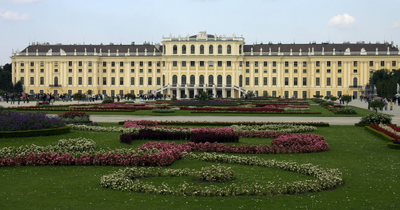 Today the Schonbrunn Palace is a World Heritage Site. It manages to maintain a perfect balance between cultural landmark and vibrant tourist stop. Not everyone realizes the magnitude of the property and the options it offers; I for one thought I’d see it all in a couple of hours. Instead I spent the entire day there and just barely managed to fit it all in. For those of you who are planning a trip to or are on your way to Vienna, skipping a visit to Schonbrunn is not a reasonable option.
Today the Schonbrunn Palace is a World Heritage Site. It manages to maintain a perfect balance between cultural landmark and vibrant tourist stop. Not everyone realizes the magnitude of the property and the options it offers; I for one thought I’d see it all in a couple of hours. Instead I spent the entire day there and just barely managed to fit it all in. For those of you who are planning a trip to or are on your way to Vienna, skipping a visit to Schonbrunn is not a reasonable option.
Here are my ten reasons to put the Schonbrunn Palace at the top of your Vienna itinerary:
Palace Tour
The Habsburgs were an extravagant lot. A walk around the palace’s luxurious halls and rooms, a viewing of the precious artwork it holds, and the history it has inspired is a testament to this very fact. Being a history buff, I especially enjoyed seeing the living chambers of Emperor Franz Joseph and his wife Elisabeth (Sisi), as well as the rooms that embody the special touch of Maria Theresa (mother of Marie Antoinette). Each room holds authentic period furnishings and art. In addition, various guestrooms and staterooms, like the great gallery which is decorated in a lavish white-gold rococo style, have been opened to the public. For the sheer dazzle effect, this tour is a must!
Palace Park
As with the stately palace, the palace park, too, is an ornate example of extravagant design. A number of walkways and trails shoot out in various directions, taking you deeper into the woods, past sculpted trees and park accents. Despite the crowds, you can always find a peaceful spot to rest under the rustling leaves of well placed trees. And as you relax in the beauty of the park, you will certainly enjoy watching young parents and their children playing in the park’s maze, a real labyrinth and playground.
Fountains and Accents
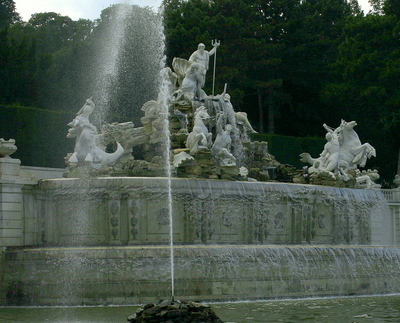 What is a palace park without a little bling? These grounds are accessorized with Roman ruins and statues of several Greek and Roman gods. They bring the same touch of opulence to the outdoors as is experienced indoors. The most elaborate feature of the park is the majestic Neptune Fountain at the foot of a hill and facing the palace. It is a composition of Neptune riding in his shell chariot which is flanked on either side by a nymph and Thetis, the goddess of the seas. Around them a number of strange and majestic mythological creatures stand, carved in white stone.
What is a palace park without a little bling? These grounds are accessorized with Roman ruins and statues of several Greek and Roman gods. They bring the same touch of opulence to the outdoors as is experienced indoors. The most elaborate feature of the park is the majestic Neptune Fountain at the foot of a hill and facing the palace. It is a composition of Neptune riding in his shell chariot which is flanked on either side by a nymph and Thetis, the goddess of the seas. Around them a number of strange and majestic mythological creatures stand, carved in white stone.
The Palm House
The Palm House dates back to the early 1880s and is one of the last of its kind in Europe. It was designed to create an environment that supported the growth of rare and exotic plants and herbs from across the world. It is comprised of three pavilions, each supporting a different ecosystem: temperate, tropical and cold climates.
The Gloriette
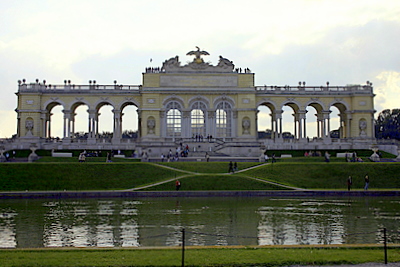 The Gloriette sits like a Baroque tiara above a hilltop overlooking the palace and the palace grounds. Constructed in 1775, the Gloriette was a resting stop for guests touring the palace grounds. Today it has been refurbished and now holds a café that allows visitors to have a bite along with stunning, sprawling views of the property.
The Gloriette sits like a Baroque tiara above a hilltop overlooking the palace and the palace grounds. Constructed in 1775, the Gloriette was a resting stop for guests touring the palace grounds. Today it has been refurbished and now holds a café that allows visitors to have a bite along with stunning, sprawling views of the property.
Carriage ride
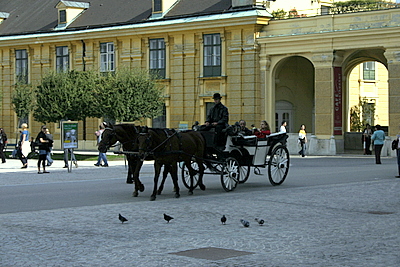 It’s easy to get nostalgic at Schonbrunn and to slip into daydreams of what life must have been like for the Habsburgs. And while that decadent lifestyle no longer exists, snatches of it have been preserved. Take the horse driven carriage ride through the property, for example. There is nothing more romantic than sitting comfortably in a buggy and viewing the property to the soothing rhythms of clip-clopping horse hooves on the cobbled pathways, much like Maria Theresa once did.
It’s easy to get nostalgic at Schonbrunn and to slip into daydreams of what life must have been like for the Habsburgs. And while that decadent lifestyle no longer exists, snatches of it have been preserved. Take the horse driven carriage ride through the property, for example. There is nothing more romantic than sitting comfortably in a buggy and viewing the property to the soothing rhythms of clip-clopping horse hooves on the cobbled pathways, much like Maria Theresa once did.
Carriage Museum
Guaranteed, this isn’t for everyone. But car enthusiasts and kids will fall in love with this quirky museum. Housed in the old riding school, the Carriage Museum (Wagenburg) displays a selection of imperial carriages, coaches, sleighs and 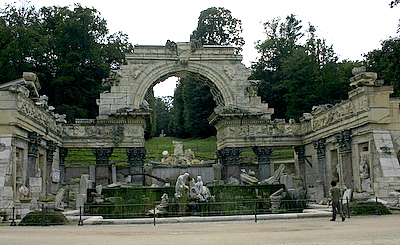 sedans. Exhibits range from ornate imperial coaches, miniature carriages for the young royals, to a car that was used to drive off the last emperor into exile in 1920.
sedans. Exhibits range from ornate imperial coaches, miniature carriages for the young royals, to a car that was used to drive off the last emperor into exile in 1920.
The Palace Orchestra
The Orangery at Schonbrunn was designed to shelter orange and lemon trees (and other plants) during winter. It soon developed as a popular venue for a range of palace festivities. This, for example, is where the likes of Mozart performed. Today, the talented palace orchestra performs some of Mozart’s best music. If you have an ear for music, this is an event you’ll truly enjoy. Tickets tend to vanish within hours and the only way to score a ticket is to book it in advance.
The Palace Zoo
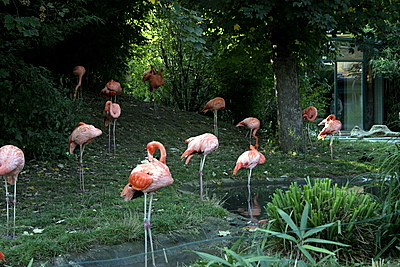 I expected a small zoo, something created for the sake of royal indulgence. Instead, I spent several awestruck hours at the expansive Tiergarten (zoo). Constructed in the 1750s on the grounds of a smaller zoo, tiergarten is designed to accommodate a variety of animals – from polar bears and pandas, to rhinos and tigers – all of whom are housed according to their home environment. I spent a good half hour in front of the panda enclosure alone, willing Fu Long, the panda, to flash me a smile. He had other ideas; he sat with his back to me, furiously chewing on a bunch of leaves.
I expected a small zoo, something created for the sake of royal indulgence. Instead, I spent several awestruck hours at the expansive Tiergarten (zoo). Constructed in the 1750s on the grounds of a smaller zoo, tiergarten is designed to accommodate a variety of animals – from polar bears and pandas, to rhinos and tigers – all of whom are housed according to their home environment. I spent a good half hour in front of the panda enclosure alone, willing Fu Long, the panda, to flash me a smile. He had other ideas; he sat with his back to me, furiously chewing on a bunch of leaves.
A Royal Meal
The palace property serves up a number of good dining options, from eateries up along the Gloriette to cafes and restaurants closer to the palace, each offering the perfect antidote for a tourist’s exhaustion. I highly recommend taking an early dinner here as there is something magical about having a meal at the palace behind a dipping sun. If you are short of time, skip the meal and stop by the Court Bakery and stock up on some Viennese apple strudel.


Comments